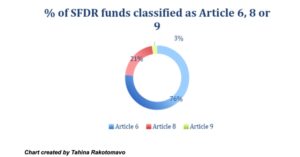The SFDR aims to tackle greenwashing information related to financial products and financial advice in the EU by enhance more reliable, comparable, and coherent information on sustainability. This Regulation should help investors having the disclosures they need to make choices in line with EU sustainability goals.
THE BACKGROUND OF SFDR
The scope covers financial market participants and financial advisers operating in the EU. The grassroots of this Regulation are deeply embedded in the work done by the HLEG (High Level Expert Group) on Sustainable Finance between 2016 and 2018. The HLEG work had two main purposes: i) integrate ESG risks into the financial system; ii) contribute redirecting capital flows towards sustainable investments. The European Commission has launched the Sustainable Finance Action Plan to implement the work made by HLEG, the SFDR is at the core of the plan.
Scope: The SFDR applies to two categories of financial firms:
- Financial advisors: They provide investment advice or insurance advice regarding insurance-based investment products (IBIPs).
- Financial market participants: They manufacture and sell financial products and perform portfolio management services.
- Examples: Asset managers, Banks, Financial advisors, Pension fund providers, Insurers
OBJECTIVES AND TOOLS: THE SFDR INTRODUCES THE PAIs (Principal Adverse Impacts).
PAIs are the negative effects on ESG factors that an investment might have. ESG factors are related to environmental, social, and employee matters, as well as Human Rights, corruption and anti-bribery. Firms above the threshold of 500 employees must disclose information related to PAIs. Firms below the 500-employee threshold, can chose whether to opt in or out of PAI reporting at firm level under Article 4 and at product level under Article 7. Article 4 embeds a “comply or explain principle“, which is broadly phrased as follows:
- Firms can choose to report the principal adverse impacts of their investment activity and report prescribed information on their website, and financial market participants must additionally report such information to investors; OR
- Firms can choose not to disclose PAIs (if below the 500 employees threshold, but they must explain why they do not consider the adverse impacts of their investment activity on sustainability factors.
Several firms have instead charted a third course: explaining that whilst they do not consider PAIs within the meaning of SFDR, they nonetheless include reporting meaningful ESG data.
Main SFDR Requirements: Sustainability impacts must be identified and disclosed at both the entity and product level.
At the entity level, the SFDR requires firms to undertake a series of disclosures:
Entity Level Disclosures
- Information on how an entity integrates sustainability risks in its investment decision‐making process or financial advice [Art.3 SFDR]
- A statement on policies about how an entity considers PAIs on sustainability factors [Art.4 SFDR]
- Information on how remuneration policies are consistent with the integration of sustainability risks [Art.5 SFDR]
- Pre-contractual disclosures on sustainability risk integration, including assessments of how the performance of financial products may be affected by those risks [Art.6 SFDR]
At the product level, the SFDR requires firms to undertake a further series of disclosures, depending on the objective of a given product:
Product Level Disclosures
- For firms that do consider PAIs, an explanation of how financial products account for these impacts should be provided. This applies to all the firm’s products, whether they are intended to meet sustainability goals or not [Art.7 SFDR]
- Products that promote “Environmental” or “Social” characteristics, must have additional information on how these targets are met, including disclosure on the degree of Taxonomy alignment of underlying economic activities [Art.8 SFDR]
- Products that have sustainable investment as an objective, must have an explanation on how the objective is achieved as well as additional disclosure on alignment with the EU Taxonomy Regulation [Art.9 SFDR]
THE IMPACT OF SFDR AND THE RISK OF GREENWASHING
The central issue is that the European Union’s new Sustainable Finance Disclosure Regulation (SFDR) still lacks any technical guidance on the criteria for compliance. This has created the risk of space for greenwashing, by letting some asset managers to make their own assumptions (and marketing strategies) categorising the funds they offer. The confusion centres around the classification of investment funds as ‘light green’ (article 8) or ‘dark green’ (article 9) according to their level of sustainability. The EC has provided some high-level, principles-based guidance (‘level 1’) but has not yet released details on exactly what qualifies in each of the categories. There are admittedly draft technical standards in circulation. But the content is likely to change because the delay in finalising it is down to disagreements between the EC and the European Parliament. The differences in opinion underscore just how difficult it is to set standards in the still nascent sustainable investment market.

SFDR: what’s next ?
The SFDR takes a phased approach to implementation with different provisions applying over an extended timeframe. Level 2 measures (Regulatory Technical Standards) will provide important details on the content and presentation of disclosures, as well as the indicators for PAIs. These Level 2 measures have not been finalised. The European Commission delayed the implementation of the second phase of the Sustainable Finance Disclosure Regulation (SFDR) until January 2023. The six-month postponement was announced in a letter to the Council of the European Union from the European Commission, dated 25 November, due to the “length and technical detail” of the directive.
Written by Paolo Vitale, Charles Deguimp and Tahina Rakotomavo
25th January 2022

